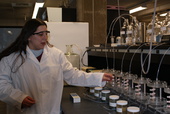Highlight
ERIE research supports innovative groundwater restoration at Western New York nuclear facility
Achievement/Results
Supported by the NSF Integrative Graduate Education and Research Traineeship (IGERT) program in Ecosystem Restoration through Interdisciplinary Exchange (ERIE), doctoral candidate Shannon Seneca and her University at Buffalo (UB) adviser Dr. Alan Rabideau performed research to support the installation of the first full scale zeolite-based permeable treatment wall at the West Valley Demonstration Project (WVDP), a former nuclear fuel reprocessing facility located in West Valley, New York, within the Lake Erie watershed. The interdisciplinary IGERT team included environmental engineers, hydrogeologists, and geochemists working with external collaborators from West Valley Environmental Services, AMEC Geomatrix, and the U.S. Department of Energy. In addition, as part of the international component of her NSF-IGERT program, Ms. Seneca received critical laboratory training from scholars the University of Waterloo, Canada.
The goal of the project was to evaluate a passive system to intercept a groundwater plume containing Strontium-90 (Sr-90) that could potentially migrate into the Lake Erie watershed. Previous efforts had provided only partial plume containment at an annual cost of several hundred thousand dollars, with significant electrical power consumption and radioactive waste generation. Following extensive laboratory testing and reactive transport modeling by the UB team, the 850 feet long permeable treatment wall was installed in fall 2010 using using a novel “trencher” technology; implementation of the new technology was accelerated by funding from the American Recovery and Reinvestment Act. Early monitoring results indicated that the system is performing as expected from both hydraulic and geochemical standpoints. An overview of the project was presented at the 2011 Waste Management Conference, with several journal articles currently in preparation. Public reaction to the project was highly favorable, as documented through numerous newspaper, television, and National Public radio outlets. Ms. Seneca’s research work involved a combination of intensive laboratory work using a surrogate (nonradioactive) form of strontium, including column experiments that extended for nearly two years coupled with the sophisticated numerical modeling of contaminant transport influenced by six-solute competitive cation exchange. She also designed and supervised column experiments on the WVDP site using “hot” ( radioactive) groundwater, thus providing the first direct experimental confirmation of the effectiveness of natural zeolite for Sr-90 removal. Following the completion of her UB IGERT doctoral program, Ms. Seneca will pursue a research career that focuses on mitigating adverse environmental impacts at former nuclear power and weapon production facilities.
Address Goals
The West Valley project represents the first full scale deployment of a passive system for removing radioactive strontium from groundwater. In addition to providing effective protection of water resources at contaminated nuclear sites, the use of natural materials in a passive and “green” mode eliminates the energy and carbon-intensive use of extraction wells. As such, the project provides new technical options for the ongoing cleanup of former nuclear facilities across the world.
The lead researcher for the project, University at Buffalo IGERT doctoral candidate Shannon Seneca is Haudenosaunee, the people of the longhouse; she is a member of the Mohawk nation and the Turtle clan.






